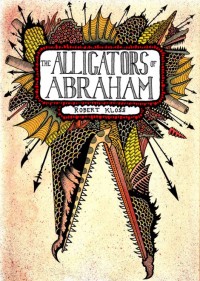25 Points: The Alligators of Abraham
 The Alligators of Abraham
The Alligators of Abraham
by Robert Kloss
Mud Luscious Press Novel(la) Series, 2012
214 pages / $15 buy from SPD or Amazon
1. Alligator: Non-commissioned submarine, completed Spring 1862 by Union Navy. Length: 14.3m. Speed: 2-4 knots. Crew: 8. Missions: Five, failures. Abandonment: Its tow ship, the U.S.S. Sumpter, cut it loose during a storm off Cape Hatteras, NC. Remains lost.
2. Abraham Lincoln visited the Alligator during its testing phase. Brutus de Villeroi’s initial design required paddle propulsion, which was later replaced by a central screw propeller.
3. (The American Annual Cyclopedia and Register of Important Events of the Year 1891): “One steamer, the ‘Louvre of Paris,’ was built and put on service [using a central screw] between Paris and London. She made a very good record for herself for nearly a year, but was unfortunately wrecked, through no fault, however, of her peculiar construction.”
4. When the alligators finally appear and begin devouring people about halfway through RK’s novella, I did one of those disorienting Google/library searches on whether a plague of alligators really followed the Civil War anywhere in the coalescing Union. I found the Alligator instead, and I couldn’t separate it from the flesh gators in the book. A plague of hungry submarines.
5. Matt Kish’s drawings are toothy reptilian sprawls of overlapping flesh and machine, gaping mouths in the process of being perfected.
6. The General, Alligators of Abraham’s marauding patriarch, shifts his bloodlust, augmented by grief over a son dead from typhoid and a suicided wife, into (self-)mutilating industry. Into a necrophilic fixation on embalming his body while still alive, and living inside the bloated corpses of alligators. Into pathetic need: “I need you here by my side. I fear I may destroy us all” (to his second son, after a second wife has left him). Into merging his sons’ identities, never naming the composite dead/alive child he (and the book) regards as you except to call him by the dead boy’s name, Walter.
7. Old Testament-fueled American novels of war rage relegate women to drawing rooms, brothels, graves, sanitariums, rumors, away. The second wife inspects a private room the General has customized for her, and says to son and husband, “Will the both of you just leave?” As if I can’t be in this room if you’re watching. And after she has packed and gone, the General says to his son, “If she weren’t gone already, I would kill her.”
8. “And your father lit kindling beneath his tin tub while infant alligators darted within, and soon the slow boil of water, and your father said into the absence, ‘I believe their hide impervious.’ And when these alligators bobbed lifeless in the bubbling, your father said, ‘They must become stronger with time.’”
9. (This Republic of Suffering: Death and the American Civil War): “Redemption and resurrection of the body were understood as physical, not just metaphysical, realities, and therefore the body, even in death and dissolution, preserved ‘a surviving identity.’ Thus the body required ‘sacred reverence and care’; the absence of such solicitude would indicate ‘a demoralized and rapidly demoralizing community.’ The body was the repository of human identity in two senses: it represented the intrinsic selfhood and individuality of a particular human, and at the same time it incarnated the very humanness of that identity—the promise of eternal life that differentiates human remains from the carcasses of animals, who possess neither consciousness of death nor promise of either physical or spiritual immortality. Such understandings of the body and its place in the universe mandated attention even when life had fled; it required what always seemed to be called ‘decent’ burial, as well as rituals fitting for the dead.”
10. Nobody in this book is decent. READ MORE >
February 12th, 2013 / 2:21 pm
